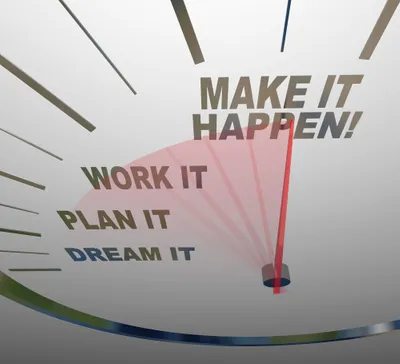With 2016 upon us, many are making plans for a healthier new year. Some may focus on less spending while others may decide to be nicer to be people, but most of us will be searching out the latest and greatest in weight loss tools, gimmicks, and programs (yet again). Unfortunately, a large percentage of us won’t make it until Valentine’s Day lamenting the money we spent on big hopes and empty promises (yet again).
If falling off the health and fitness bandwagon is not on your list of goals for the year, check out our list of important considerations before launching into a new program. By getting a clear picture of what we need and what we can give to our health and fitness, we are more able to set realistic (and achievable) goals…
1. Gym or Outdoors?
There are 2 types of people in the world—those that love and crave the gym and those that would rather poke their eye out with a sharp instrument. Unfortunately, the latter will still try and fit themselves into the gym mold with the same amount of tenacity as a spider trying to climb out of a toilet bowl.
If the thought of going to a gym is causing a rash, it is important to note that research suggests exercising outdoors is one of the best ways to achieve both physical and mental health. A connection with nature and breathing the fresh air (versus the stink of sweat, rubber, and cleaning agent) combined with physical activity will deliver all the benefits without the exposure to lycra-spandex (not that there’s anything wrong with that).
2. Group or Individual Fitness?
Lucky for us, there are many ways we can spend our physical activity time. Some love the connection and motivation that results from working out in a group, while others appreciate the solitude that comes with exercising alone.
There is no “right or wrong” way to exercise if it energizes and motivates us. Individual conditioning may be highly motivational if one is able to plug into their favorite music and tune the world out for 30 minutes. Others may benefit from the accountability that comes from exercising with others. The choice is ours.
3. Running, Swimming, CrossFit…Oh My!
We have finally made the commitment to our health and are ready to select our modality of exercise, but how do we make a choice? With all the options out there, we would have to be fluent in exercise science to understand the pros and cons of everything the fitness industry has to offer.
The good news is researchers in exercise psychology have found a strong positive relationship between enjoyment (intrinsic motivation) and exercise adherence. Conversely, those exercise newbies that jumped on the fitness bandwagon for reasons related to body changes (extrinsic motivation) soon fell off. By taking the time to try a fitness program on for size and move to the next option if it isn’t for us, is one of the best ways to ensure long term participation.
4. Going Wheatless, Meatless, or Raw?
Depending on who we talk to, we will always get a difference of opinion when it comes to healthy nutrition. In fact, when broaching the topic of nutrition, many of us have become followers of a certain kind of “kitchen spirituality” latching on to our favorite food theory and will defend our choices like a lion defends her cub.
From choosing to eliminate wheat, meat, cooked veggies, or anything that begins with the letter “a”, it can turn one’s stomach just trying to pick a healthy menu. Quite simply, if one is focused on eating a half a plate of veggies per meal coupled with reducing sugar intake to approximately 4 to 6 teaspoons a day while focusing on whole foods and less processed…we are doing very well indeed (and the rest is just white noise).
5. High or Low Tech?
No doubt there were many high tech lifestyle monitors under the tree or tucked into stockings this holiday season. From wearables for the wrist to smart phone aps that help us track everything from steps to calories, high tech fitness and health products is all the rage.
The only thing technology doesn’t do is pull us off the couch when we ignore it or talk us into going for a walk when we would rather eat chips and binge on TV. Technology will never replace psychology. It’s one thing to gather our information on daily movement, sleep patterns, and caloric intake and another altogether to do something about it.
6. Long Term or Short Term?
When making New Year’s goals for ourselves it is rare for us to think long term. We may declare a desire to lose 10 pounds for the summer or for that winter getaway coming up in 12 weeks, but what about for the rest of our lives? For that, we must focus on small (a.k.a. tiny) steps that will allow us to make lasting changes.
For example, if our long term goal is to become 12 pounds lighter a year from now, our short term goals may be to focus on a 1 pound weight loss for each month. Considering momentary lapses through the change process, it provides us with a realistic buffer to attain our long term goal by next December.
7. Need or Want?
Many of us want to “want” to make change. We will go as far as attempting a change in our lifestyle only to hit enough roadblocks to solidify our belief that we cannot change. For others the pain of staying the same is more uncomfortable than the change itself. When the need for change overrides the desire to stay the same, not only will change occur, but it will last.
It is important to know ourselves enough to understand what we need and what we want may influence our goal achievement. For example, we may want to reduce salt intake because of health concerns; we may feel the need to visit the pub for nachos and beer with our buddies.
8. Reality or Fantasy?
Unfortunately, the pressure to be thin, beautiful, and young sometimes clouds all reasoning resulting in unrealistic goals that will never be realized. Although we share many human traits, our bodies take on many different shapes. Some may shed or maintain weight easier than others while some may be built altogether differently.
One of the hardest tips to a life of good physical and mental health is that of acceptance. We need to start accepting what we can change and what we can’t. Only then will we find peace with who we are, what we look like, and focus on more important things in life.
9. Expensive or Cheap?
We can blame the health and fitness industry for the belief that attaining good health and fitness costs money. From fitness equipment like techno-shoes and specialized running shirts to exercise gizmos that record our every movement, many contemplators of exercise shy away due to the perception of high cost.
Exercise and eating well does not have to cost us the low-techno cotton T-shirts off our backs. Walking is one exercise that costs little. Plus, by trading in a few process food items for a few more whole foods, one can balance their budget and reach their health goals without going into debt.
10. Life Long or Until Valentine’s Day?
This last consideration is the most important as we move into our resolution season. Research tells us that most goals are forgotten within a 6 month period. Many fitness trainers and health promoters could attest to seeing lowered motivation and discarded fitness memberships by Valentine’s Day.
When it comes to goal setting, we tend to bite off more than we can chew. From unrealistic goals and unacknowledged time constraints to overlooking enjoyment and actions plans for those times we fall off the proverbial wagon—planning is the most important factor for success. So don’t be a statistic this year. Take the time to consider every aspect of change and this year may prove to be a great success!













